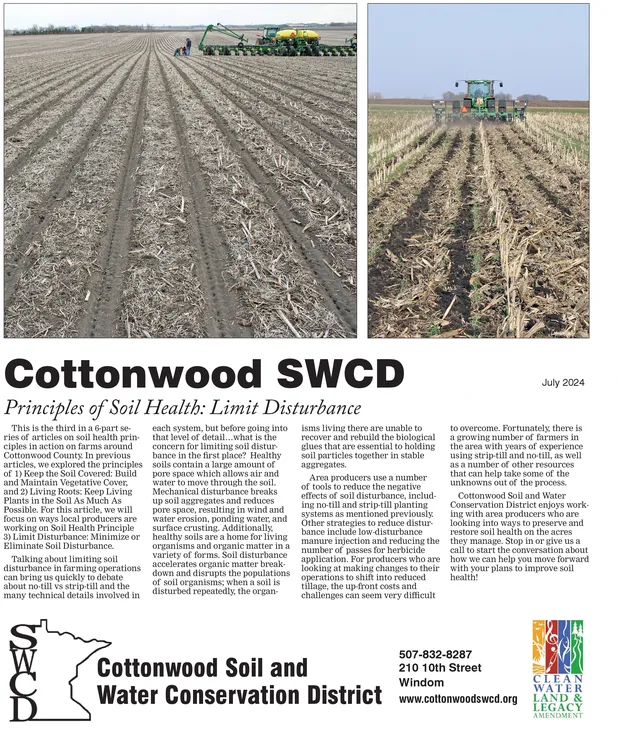Advertisement

-
Published Date
July 31, 2024This ad was originally published on this date and may contain an offer that is no longer valid. To learn more about this business and its most recent offers, click here.
Ad Text
Cottonwood SWCD Principles of Soil Health: Limit Disturbance This is the third in a 6-part se- ries of articles on soil health prin ciples in action on farms around Cottonwood County. In previous articles, we explored the principles of 1) Keep the Soil Covered: Build and Maintain Vegetative Cover, and 2) Living Roots: Keep Living Plants in the Soil As Much As Possible. For this article, we will focus on ways local producers are working on Soil Health Principle 3) Limit Disturbance: Minimize or Eliminate Soil Disturbance. Talking about limiting soil disturbance in farming operations can bring us quickly to debate about no-till vs strip-till and the many technical details involved in each system, but before going into that level of detail...what is the concern for limiting soil distur bance in the first place? Healthy soils contain a large amount of pore space which allows air and water to move through the soil. Mechanical disturbance breaks up soil aggregates and reduces pore space, resulting in wind and water erosion, ponding water, and surface crusting. Additionally. healthy soils are a home for living organisms and organic matter in a variety of forms. Soil disturbance accelerates organic matter break- down and disrupts the populations of soil organisms; when a soil is disturbed repeatedly, the organ- isms living there are unable to recover and rebuild the biological glues that are essential to holding soil particles together in stable aggregates. Area producers use a number of tools to reduce the negative effects of soil disturbance, includ- ing no-till and strip-till planting systems as mentioned previously Other strategies to reduce distur bance include low-disturbance manure injection and reducing the number of passes for herbicide application. For producers who are looking at making changes to their operations to shift into reduced tillage, the up-front costs and challenges can seem very difficult July 2024 to overcome. Fortunately, there is a growing number of farmers in the area with years of experience using strip-till and no-till, as well as a number of other resources that can help take some of the unknowns out of the process. Cottonwood Soil and Water Conservation District enjoys work- ing with area producers who are looking into ways to preserve and restore soil health on the acres they manage. Stop in or give us a call to start the conversation about how we can help you move forward with your plans to improve soil health! Cottonwood Soil and 507-832-8287 210 10th Street Windom CLEAN WATER Water Conservation District www.cottonwoodswcd.org LEGACY AMENDMENT Cottonwood SWCD Principles of Soil Health : Limit Disturbance This is the third in a 6 - part se- ries of articles on soil health prin ciples in action on farms around Cottonwood County . In previous articles , we explored the principles of 1 ) Keep the Soil Covered : Build and Maintain Vegetative Cover , and 2 ) Living Roots : Keep Living Plants in the Soil As Much As Possible . For this article , we will focus on ways local producers are working on Soil Health Principle 3 ) Limit Disturbance : Minimize or Eliminate Soil Disturbance . Talking about limiting soil disturbance in farming operations can bring us quickly to debate about no - till vs strip - till and the many technical details involved in each system , but before going into that level of detail ... what is the concern for limiting soil distur bance in the first place ? Healthy soils contain a large amount of pore space which allows air and water to move through the soil . Mechanical disturbance breaks up soil aggregates and reduces pore space , resulting in wind and water erosion , ponding water , and surface crusting . Additionally . healthy soils are a home for living organisms and organic matter in a variety of forms . Soil disturbance accelerates organic matter break- down and disrupts the populations of soil organisms ; when a soil is disturbed repeatedly , the organ- isms living there are unable to recover and rebuild the biological glues that are essential to holding soil particles together in stable aggregates . Area producers use a number of tools to reduce the negative effects of soil disturbance , includ- ing no - till and strip - till planting systems as mentioned previously Other strategies to reduce distur bance include low - disturbance manure injection and reducing the number of passes for herbicide application . For producers who are looking at making changes to their operations to shift into reduced tillage , the up - front costs and challenges can seem very difficult July 2024 to overcome . Fortunately , there is a growing number of farmers in the area with years of experience using strip - till and no - till , as well as a number of other resources that can help take some of the unknowns out of the process . Cottonwood Soil and Water Conservation District enjoys work- ing with area producers who are looking into ways to preserve and restore soil health on the acres they manage . Stop in or give us a call to start the conversation about how we can help you move forward with your plans to improve soil health ! Cottonwood Soil and 507-832-8287 210 10th Street Windom CLEAN WATER Water Conservation District www.cottonwoodswcd.org LEGACY AMENDMENT
